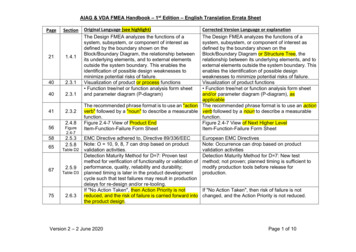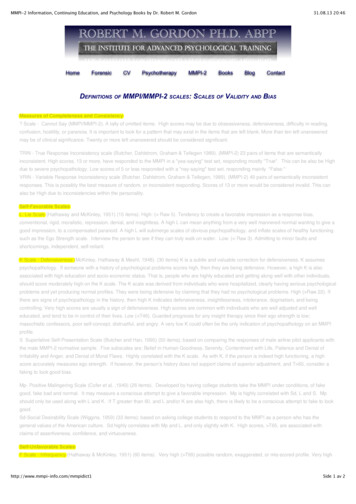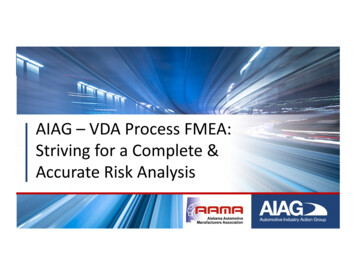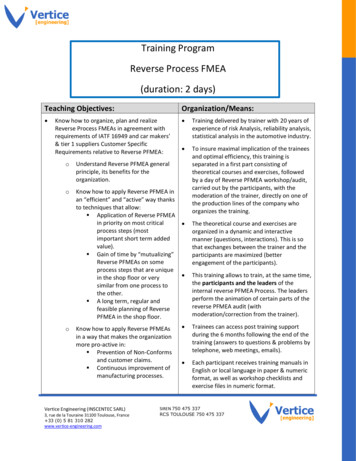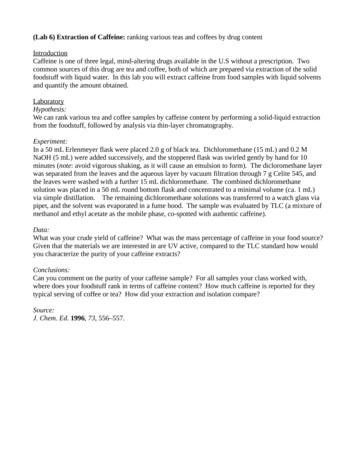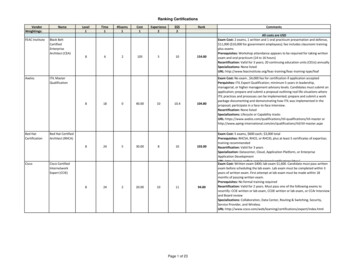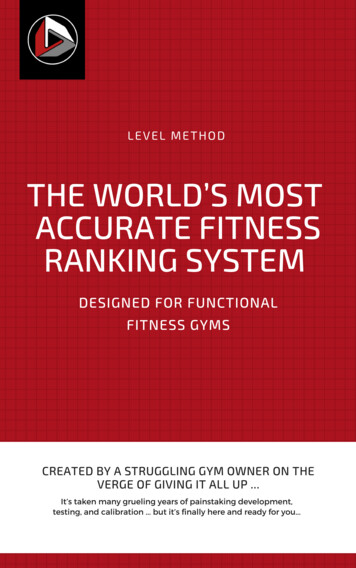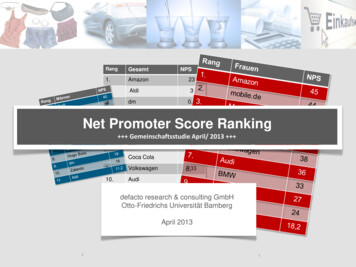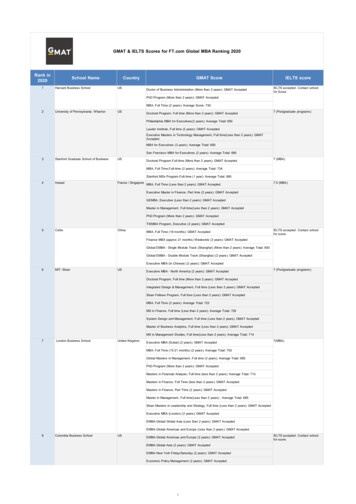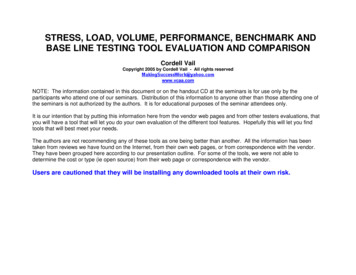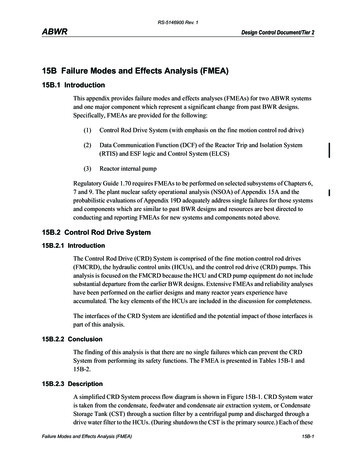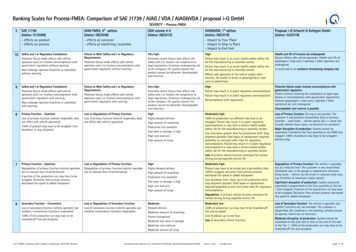
Transcription
Ranking Scales for Process-FMEA: Comparison of SAE J1739 / AIAG / VDA / AIAG&VDA / proposal i-Q GmbHSEVERITY – Process-FMEASSAE J1739(status: 01/2009)- effects on product- effects on process10 Safety and / or Regulatory Compliance:Potential failure mode affects safe vehicleoperation and / or involves noncompliance withgovernment regulation without warning.May endanger operator (machine or assembly)without warning.AIAG FMEA, 4th edition(status: 06/2008)- effects at customer- effects at machining / assemblyVDA volume 4-II(status: 06/2012)AIAG&VDA, 1st edition(status: 06/2019)- Impact to Your Plant- Impact to Ship to Plant- Impact to End UserProposal i-Q Schacht & Kollegen GmbH(status: 03/2018)Failure to Meet Safety and / or RegulatoryRequirements:Potential failure mode affects safe vehicleoperation and / or involves noncompliance withgovernment regulation without warning.Very high:Extremely severe failure that affects thesafety and / or violates the compliance tolegal regulations. Existence-endangering riskto the company. For quality reasons theproduct cannot be delivered. Unacceptablecost overruns.High:Failure may result in an acute health and/or safety riskfor the manufacturing or assembly worker.Failure may result in an acute health and/or safety riskfor the manufacturing or assembly worker.Affects safe operation of the vehicle and/or othervehicles, the health of driver or passenger(s) or roadusers or pedestrians.Health and life of humans are endangered:Failure affects safe vehicle operation. Health and life ofpassengers / road users / operator / other operators areendangered.It could lead to an existence threatening company risk.9Safety and / or Regulatory Compliance:Potential failure mode affects safe vehicleoperation and / or involves noncompliance withgovernment regulation with warning.May endanger operator (machine or assembly)with warning.Failure to Meet Safety and / or RegulatoryRequirements:Potential failure mode affects safe vehicleoperation and / or involves noncompliance withgovernment regulation with warning.Very high:Extremely severe failure that affects thesafety and / or violates the compliance tolegal regulations. Existence-endangering riskto the company. For quality reasons theproduct cannot be delivered. Unacceptablecost overruns.High:Failure may result in in-plant regulatory noncompliance.Failure may result in in-plant regulatory noncompliance.Noncompliance with regulationsPotential failure mode involves noncompliance withgovernment regulation:Failure involves violating the compliance to legal regulations or noncompliance with government regulations.Humans (passengers / road users / operator / otheroperators) are not endangered.Unacceptable cost overrun is possible.8Primary Function – Essential:Loss of primary function (vehicle inoperable, doesnot affect safe vehicle operation).100% of product may have to be scrapped. Lineshutdown or stop shipment.Loss or Degradation of Primary Function:Loss of primary function (vehicle inoperable, doesnot affect safe vehicle operation).High:Highly delayed deliveryHigh amount of reworkingProduction line standstillTool wear or damage is highHigh cost overrunsHigh amount of scrapModerately high:100% of production run affected may have to bescrapped. Failure may result in in-plant regulatorynoncompliance or may have a chronic health and/orsafety risk for the manufacturing or assembly worker.Line shut down greater than full production shift. Stopshipment possible; field repair or replacement required(assembly to end user) other than for regulatorynoncompliance. Failure may result in in-plant regulatorynoncompliance or may have a chronic health and/orsafety risk for the manufacturing or assembly worker.Loss of primary vehicle function necessary for normaldriving during expected service life.Loss of Primary Function: Driving is not possible. Thecustomer is extraordinary dissatisfied. (Loss of primaryfunction – walk home – vehicle stands still driver hasto walk. Vehicle slows down, no hazard of an accident.)Major disruption of production: System cannot beassembled / flashed at the final assembly at the OEM (linestopper). 100% of products may have to be scrapped –delivery stop.7Primary Function – Essential:Degradation of primary function (vehicle operable,but at reduced level of performance)A portion of the production run may have to bescrapped. Deviation from primary process;decreased line speed or added manpower.Loss or Degradation of Primary Function:Degradation of primary function (vehicle operable,but at reduced level of performance).High:Highly delayed deliveryHigh amount of reworkingProduction line standstillTool wear or damage is highHigh cost overrunsHigh amount of scrapModerately high:Product may have to be sorted and a portion(less than100%) scrapped; deviation from primary process;decreased line speed or added manpower.Line shutdown from 1hour up to full production shift;stop shipment possible; field repair or replacementrequired (assembly to end user) other than for regulatorynoncompliance.Degradation of primary vehicle function necessary fornormal driving during expected service life.Degradation of Primary Function: The vehicle is operable,but at a reduced level. The customer is very dissatisfied.Immediate stay in the garage is imperatively necessary.(Limp home – vehicle can be driven in reduced mode only,e.g. limitation of maximum engine speed.)Significant disruption of production: System cannot beassembled / programmed at the final assembly at the tier1 (line stopper). A portion of the production run may haveto be scrapped. Deviation from primary process; decreasedline speed or added manpower.6Secondary Function – Convenient:Loss of secondary function (vehicle operable, butcomfort / convenience functions inoperable).100% of the production run may have to bereworked off line and accepted.Loss or Degradation of Secondary Function:Loss of secondary function (vehicle operable, butcomfort/ convenience functions inoperable).Moderate:Delayed deliveryModerate amount of reworkingProcess disruptionsModerate tool wear or damageModerate cost overrunsModerate amount of scrapModerately low:100% of production run may have to be reworked offline and accepted.Line shutdown up to one hourLoss of secondary vehicle function.Loss of Secondary Function: The vehicle is operable, butcomfort functions are not available. The customer isdissatisfied. (Air condition is not working, window cannotbe opened, hybrid has no function.)Moderate disruption of production: System cannot beassembled at the pilot belt or fails at the end of line testat the Tier 1. 100% of the production run may have to bereworked off line and accepted.i-Q P-FMEA ranking-scales english comparison 2019-08-18.docxtranslated and layoutet by i-Q Schacht & Kollegen Qualitätskonstruktion GmbH -- www. i-q.de -- info@i-q.depage 1 / 10
Ranking Scales for Process-FMEA: Comparison of SAE J1739 / AIAG / VDA / AIAG&VDA / proposal i-Q GmbHSSAE J1739(status: 01/2009)- effects on product- effects on processAIAG FMEA, 4th edition(status: 06/2008)- effects at customer- effects at machining / assemblyVDA volume 4-II(status: 06/2012)AIAG&VDA, 1st edition(status: 06/2019)- Impact to Your Plant- Impact to Ship to Plant- Impact to End UserProposal i-Q Schacht & Kollegen GmbH(status: 03/2018)5Secondary Function – Convenient:Degradation of secondary function (vehicleoperable, but comfort / convenience functions atreduced level of performance).A portion of the production run may have to bereworked offline and accepted.Loss or Degradation of Secondary Function:Degradation of secondary function (vehicleoperable, but comfort/convenience functions atreduced level of performance).Moderate:Delayed deliveryModerate amount of reworkingProcess disruptionsModerate tool wear or damageModerate cost overrunsModerate amount of scrapModerately low:A portion of the production run may have to bereworked off line and accepted.Less than 100% of product affected; strong possibilityfor additional defective product; sort required; no lineshutdownDegradation of secondary vehicle function.Degradation of Secondary Function: The vehicle isoperable, but comfort functions are working at a reducedlevel. The customer is somewhat dissatisfied. (Aircondition is not working properly, window opens slowly,radio disturbance, hybrid has no full function.)Moderate disruption of production: System cannot beassembled at the prototype building / set into function orfails at the function test. A portion of the production runmay have to be reworked offline and accepted.4Annoyance:Appearance or Audible Noise, vehicle operable,item does not comfort. Defect noticed by mostcustomers ( 75%).100% of the production run may have to bereworked in station before it is processed.Annoyance:Appearance or Audible Noise, vehicle operable,item does not conform and noticed by mostcustomers ( 75%).Moderate:Delayed deliveryModerate amount of reworkingProcess disruptionsModerate tool wear or damageModerate cost overrunsModerate amount of scrapModerately low:100% of production run may have to be reworked instation before it is processed.Defective product triggers significant reaction plan;additional defective products not likely; sort notrequired.Very objectionable appearance, sound, vibration,harshness, or haptics.Fit & appearance / noises are disturbing: Failure is noticedby most customers ( 75%). (Almost all customers willnotice the failure, even non-critical representatives!)Disturbance of our senses: hearing / seeing / feeling /smelling / (tasting)Minor disruption of production: 100% of the productionrun may have to be reworked in station before it can beprocessed.3Annoyance:Appearance or Audible Noise, vehicle operable,item does not comfort. Defect noticed by manycustomers (50%).A portion of the production run may have to bereworked in station before it is processed.Annoyance:Appearance or Audible Noise, vehicle operable,item does not conform and noticed by manycustomers (50%).Low:Little reworkingLow process disruptionLow cost overrunsLow amount of scrapLow:A portion of the production run may have to bereworked in-station before it is processed.Defective product triggers minor reaction plan;additional defective products not likely; sort notrequired.Moderately objectionable appearance, sound, vibration,harshness, or haptics.Fit & appearance / noises are disturbing: Failure is noticedby many customers ( 50%). (On average every secondcustomer will notice the failure.) Disturbance of oursenses: hearing / seeing / feeling / smelling / (tasting)Low inconvenience of production: A portion of theproduction run may have to be reworked in station beforeit can be processed.2Annoyance:Appearance or Audible Noise, vehicle operable,item does not conform. Defect noticed bydiscriminating customers ( 25%).Slight inconvenience to process, operation oroperator.Annoyance:Appearance or Audible Noise, vehicle operable,item does not conform and noticed bydiscriminating customers ( 25%).Low:Little reworkingLow process disruptionLow cost overrunsLow amount of scrapLow:Slight inconvenience to process, operation, or operator.Defective product triggers no reaction plan; additionaldefective products not likely; sort not required; requiresfeedback to supplier.Slightly objectionable appearance, sound, vibration,harshness, or haptics.Fit & appearance / noises are rarely disturbing: Failure isnoticed by some customers ( 25%). (Those customers canhear the grass growing. ) Disturbance of our senses:hearing / seeing / feeling / smelling / (tasting)Very low inconvenience of production: Slightinconvenience to process, operation or operator.1No effect:No discernible effect.No effect:No discernible effect.Very Low:Very low, acceptable cost overrunVery low:No discernible effect.No discernible effect or no effect.No discernible effect.No discernible effect: Only identifiable by qualifiedpersonnel. (But out of tolerances; at this point thetolerances have to be considered.)No inconvenience in production.i-Q P-FMEA ranking-scales english comparison 2019-08-18.docxtranslated and layoutet by i-Q Schacht & Kollegen Qualitätskonstruktion GmbH -- www. i-q.de -- info@i-q.depage 2 / 10
Ranking Scales for Process-FMEA: Comparison of SAE J1739 / AIAG / VDA / AIAG&VDA / proposal i-Q GmbHOCCURRENCE – Process-FMEAAIAG FMEA, 4th edition(status: 06/2008)(incidents per items/vehicles)VDA volume 4-II(status: 06/2012)- Process design- Process design failure rate in ppmAIAG&VDA, 1st edition(status: 06/2019)- Prediction of Failure Cause Occurring- Type of Control- Prevention Controls (*)Proposal i-Q Schacht & Kollegen GmbH(status: 03/2018) 100 per thousand pieces 1 in 10Very High: 100 per thousand 1 in 10Very High:New process without experience.(500,000 ppm)Extremely high:NoneNo prevention controls.Always:New process without experience.100.000 ppm / 1 failure per 10 parts / Cpk 0,43Permanent failure9High:50 per thousand pieces1 in 20High:50 per thousand1 in 20Very High:New process without experience.(100,000 ppm)Very high:BehavioralPrevention controls will have little effect in preventing failure causes.Very high:New process without experience.50.000 ppm / 1 failure per 20 parts / Cpk 0,55Multiple failures per hour8High:20 per thousand pieces1 in 50High:20 per thousand1 in 50High:New process with known but problematicprocedure.(30,000 ppm)Very high:BehavioralPrevention controls will have little effect in preventing failure causes.High:New process with known but problematic procedure.20.000 ppm / 1 failure per 50 parts / Cpk 0,68One failure per hour7High:10 per thousand pieces1 in 100High:10 per thousand1 in 100HighNew process with known but problematicprocedure.(10,000 ppm)High:Behavioral or TechnicalPrevention controls somewhat effective in preventing failure causes.Significant:New process with known but problematic procedure10.000 ppm / 1 failure per 100 parts / Cpk 0,77One failure per shift6Moderate:2 per thousand pieces1 in 500Moderate:2 per thousand1
Ranking Scales for Process-FMEA: Comparison of SAE J1739 / AIAG / VDA / AIAG&VDA / proposal i-Q GmbH OCCURRENCE – Process-FMEA O SAE J1739 (status: 01/2009) (incidents per 1.000 items/ vehicles) AIAG FMEA, 4th edition (status: 06/2008) (incidents per items/ vehicles) VDA volume 4-II (status: 06/2012) - Process design
